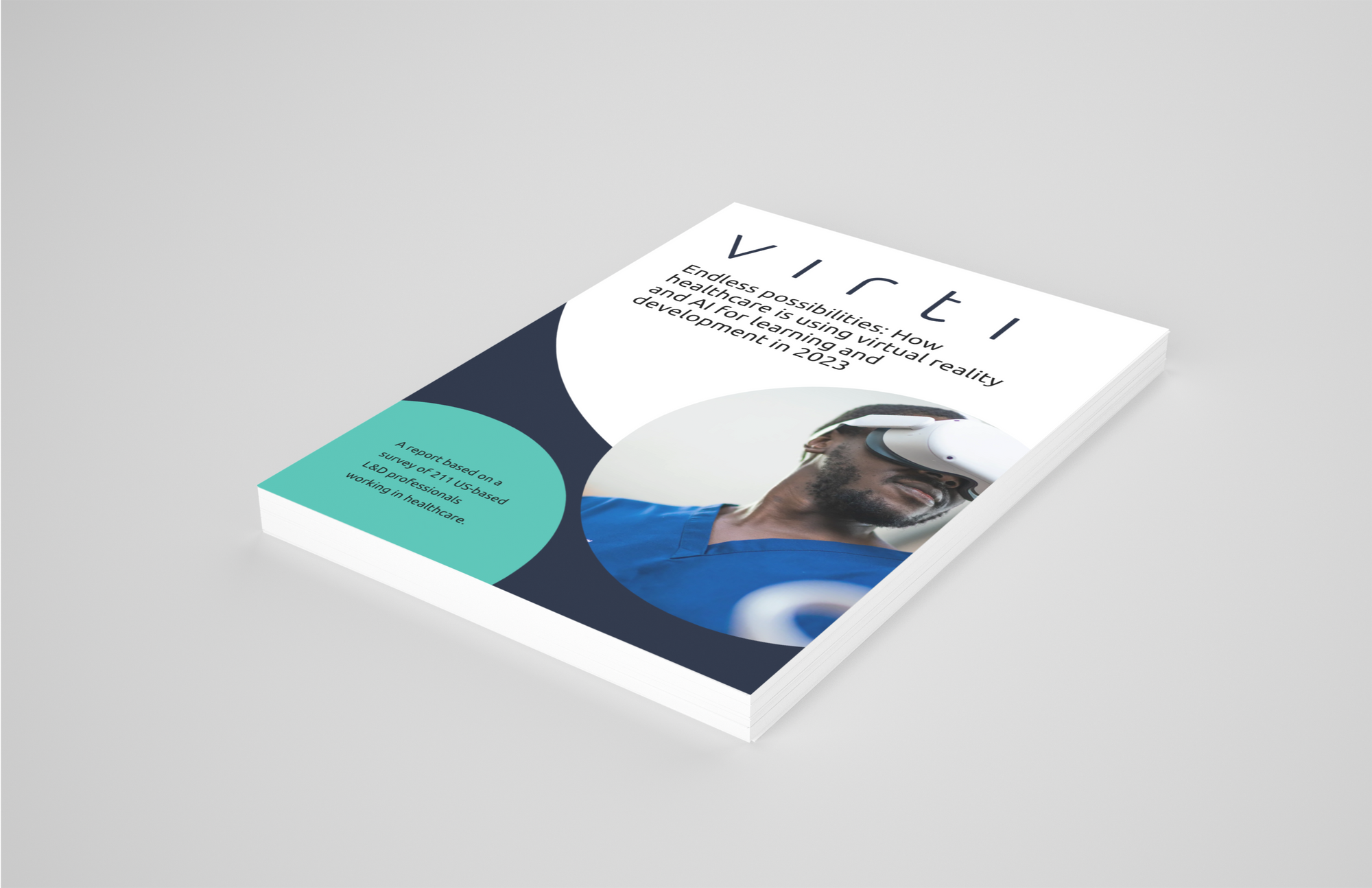Learning and Development Professionals Employed in Healthcare Say “Possibilities are Endless” for Generative Artificial Intelligence; 88% See Potential

Healthcare Ramps up Training Tech as Survey Finds 77% Have Implemented or Plan to Implement Immersive Tools Like Virtual Reality
New York, NY – October 12, 2023 – Most learning and development (L&D) professionals employed in healthcare in the U.S. have high hopes for generative artificial intelligence (AI). Nearly nine in 10 respondents (88%) say generative AI has at least moderate potential – and 61% believe it has “high potential” (36%) or “very high potential” (25%). “It's innovative and the possibilities are endless,” wrote one respondent in open-ended comments.
That’s according to a new report by Virti titled, “Endless possibilities: How healthcare is using virtual reality and AI for learning and development in 2023.” The findings are based on a survey of 211 U.S.-based L&D professionals working for U.S. healthcare organizations such as hospitals and clinics – along with supplementary interviews that illustrate examples in practice.
“The widespread exposure to generative AI is likely attributable to buzzy tools like ChatGPT from Open AI,” said Virti CEO Kurt Kratchman. “One respondent wrote in an open-ended comment that the ‘possibilities are endless.’”
This isn’t by chance either: A comparative analysis found the more familiar a respondent was with generative AI, the more conviction they expressed in its potential to enhance healthcare training. Exactly half of respondents (50%) have personally experimented with generative AI – and another 31% said they plan to do so.
Immersive training tech is gaining traction
Immersive technology tools such as virtual reality (VR) and augmented reality (AR) are even further along. A whopping 85% are at least “somewhat familiar” with immersive training tools – compared with 77% who said the same about generative AI.
One reason familiarity is so high is that more than three-quarters of respondents work for organizations that either have implemented (34%) or plan to implement (43%) VR/AR tools.
Interest in the possibilities appears to be growing too. More than half of respondents (64%) say there is “more interest” or “much more interest” in immersive tech today than there was three years ago.
Wide-ranging VR use cases in healthcare
The use cases for immersive technology for L&D purposes in healthcare are wide-ranging. These span from practicing emergency medical procedures and pre-operative preparation – to foundational medical training and communication skills.
Which use cases have the most potential can vary from organization to organization. However, out of all the possible use cases, a majority of respondents identified four as having “high potential.”
These include:
- Safety or hazard awareness training (60%);
- Train, practice or rehearse complex or emergency situations (56%);
- Foundational medical education (52%); and
- Preparing for procedures (i.e., pre-operative) (51%).
Students perform medical interviews with an AI “patient”
One example in the report describes how one university has been running a pilot program offering simulations to medical, nursing and respiratory care students, among others. This includes a medical interview with “Mike White”– an avatar powered by generative artificial intelligence (AI).
Students are required to physically check vital signs, such as measuring the patient’s blood pressure, taking their temperature, listening to their heart and lungs – and even conducting a capillary refill – during the simulation. Importantly, the interpersonal training – demonstrating good bedside manners – is as central to the lesson as asking the right questions and the physical exam.
The immersive nature of this class is a vast improvement over how it was previously taught: with traditional video and lectures. While the session used to be held later in the semester, students and faculty alike requested it be conducted sooner, so that by the time they get their clinical studies, the students have already had practice in the simulation.
Other high-level findings from the survey include the following:
- Realism in healthcare training is crucial. 86% of respondents say realism is “very” or “extremely important.” Nine in 10 say their organization strives to create a sense of realism in training at least some of the time.
- Most common tools in use limit realism. The most common tech tools in use by healthcare L&D are online learning (72%) and video conferencing (54%). Despite the broad enthusiasm for realism, less than one-third are using tools – real or virtual – to support simulated training.
- Familiarity with generative AI is high. 77% of respondents said they were familiar with generative artificial intelligence (AI). 50% have personally experimented with it; another 31% said plan to do so.
- Immersion accelerates learning and improves clinical performance. The top benefits respondents identified link L&D to performance. Respondents indicated trainees learn faster in immersive environments (49%) – and it improves clinical performance (46%).
- Healthcare organizations are generally supportive of L&D. 74% of respondents “agree” (40%) or “strongly agree” (34%) that their organization is committed to funding new technologies for L&D. More than half (68%) indicate their organization is supportive of L&D “always” (32%) or “often” (36%).
“One of the most interesting findings from the survey is that respondents see a clear link between immersive learning technologies and clinical performance,” added Kratchman. “Whether it’s a single doctor learning a new surgical procedure from a top surgeon – or training the next generation of nurses – students learn faster and retain what they’ve learned. This is naturally parlayed into better performance in practice.”
A complimentary copy of the report is available for download here: “Endless possibilities: How healthcare is using virtual reality and AI for learning and development in 2023.”

